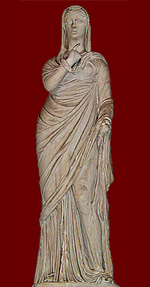
The “Pudicitia Pose”

Livy recounts how the noblewoman Verginia, daughter of an ancient consular family, the Verginii, and spouse of a plebeian military hero and political leader, confronted the patrician matrons over the right to worship at the state patrician shrine in the Forum Boarium (the precise location of the shrine is unknown) of the personified female virtue Pudicitia (see coin for an image). Devoted to the modest behavior expected of noble matrons, the cult was open only to married women of the patrician class who were both chaste and univira (married only once). The patrician women judged that Verginia had lost her elite class privileges by marrying out of her rank, an option open to citizens from 445 BCE and the first victory in the long struggle between the orders for equal constitional rights. Although by this time plebeians had access to consular office—in 296 BCE Verginia's husband was in his second term as consul—yet another secession of the Plebs, the third and final, would take place in 287 BCE. Livy's account of the origin of the cult of Pudicitia Plebeia demonstrates the extension to women of the class warfare and, under the leadership of a strong, articulate, intelligent woman, their arrival at a typically Roman compromise that avoided civic violence, retained division between the classes, and satisfied both sides, if only temporarily. For further reading on the topic, see Valerius Maximus, Facta et Dicta 6.1.pr-13 (De Pudicitia); I. Maehle on female cults.
XXIII. Eo anno prodigia multa fuerunt, quorum averruncandorum causa supplicationes in biduum senatus decrevit;
[2]
![]() publice vinum ac
tus
praebitum;
supplicatum
iere
frequentes viri feminaeque.
publice vinum ac
tus
praebitum;
supplicatum
iere
frequentes viri feminaeque.
[3]
![]() Insignem supplicationem fecit
certamen in
sacello
Pudicitiae
Patriciae (quae in Foro
Bovario est ad
aedem
rotundam Herculis) inter matronas
ortum.
Insignem supplicationem fecit
certamen in
sacello
Pudicitiae
Patriciae (quae in Foro
Bovario est ad
aedem
rotundam Herculis) inter matronas
ortum.
[4] Verginiam Auli filiam, patriciam plebeio nuptam, L. Volumnio consuli, matronae quod e patribus enupsisset sacris arcuerant. Brevis altercatio inde ex iracundia muliebri in contentionem animorum exarsit,
[5] cum se Verginia et patriciam et pudicam in Patriciae Pudicitiae templum ingressam, ut uni nuptam ad quem virgo deducta sit, nec se viri honorumve eius ac rerum gestarum paenitere vero gloriaretur.
[6]
![]() Facto deinde egregio
magnifica verba
adauxit. In
Vico
Longo ubi habitabat,
ex parte aedium quod
satis esset loci
modico
sacello
exclusit
Facto deinde egregio
magnifica verba
adauxit. In
Vico
Longo ubi habitabat,
ex parte aedium quod
satis esset loci
modico
sacello
exclusit
![]() aramque ibi posuit et convocatis plebeiis
matronis
conquesta iniuriam patriciarum,
aramque ibi posuit et convocatis plebeiis
matronis
conquesta iniuriam patriciarum,
![]()
[7]
![]() “hanc ego aram” inquit
“Pudicitiae Plebeiae
dedico; vosque
hortor ut,
quod certamen virtutis viros in hac civitate
tenet,
“hanc ego aram” inquit
“Pudicitiae Plebeiae
dedico; vosque
hortor ut,
quod certamen virtutis viros in hac civitate
tenet,
[8] hoc pudicitiae inter matronas sit detisque operam ut haec ara quam illa, si quid potest,
[9]
![]() sanctius et a
castioribus
coli dicatur.” eodem
ferme
ritu et haec ara quo illa antiquior culta est,
ut nulla nisi
spectatae pudicitiae matrona
et quae uni viro nupta fuisset
ius
sacrificandi haberet
sanctius et a
castioribus
coli dicatur.” eodem
ferme
ritu et haec ara quo illa antiquior culta est,
ut nulla nisi
spectatae pudicitiae matrona
et quae uni viro nupta fuisset
ius
sacrificandi haberet
[10] volgata dein religio a pollutis, nec matronis solum sed omnis ordinis feminis, postremo in oblivionem venit.
Click on the underlined words for translation aids and commentary, which will appear in a small window. Click on the icon link![]() to the right of the text for related images and information.
to the right of the text for related images and information.